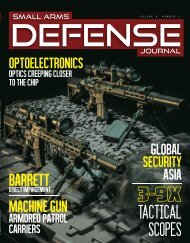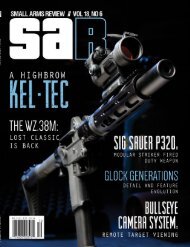Create successful ePaper yourself
Turn your PDF publications into a flip-book with our unique Google optimized e-Paper software.
operational (internally powered) combat<br />
suit prototype system by 2018.<br />
Beyond unanticipated developmental<br />
costs, there are a number of scientific<br />
and technical development issues that may<br />
slow TALOS’s realization. Because some<br />
of the TALOS technologies simply don’t<br />
exist today, a number of scientists and<br />
engineers close to the project believe that<br />
TALOS, as envisioned, probably can’t be<br />
achieved before 2025. TALOS technologies<br />
needing development include next-generation<br />
full-body ballistic armor materials,<br />
powered exoskeletons for mobility and<br />
agility, conformable and wearable power<br />
generation, suit thermal management,<br />
computers, communications, antennae,<br />
and real-time combat-ready displays with<br />
non-traditional information presentation,<br />
as well as embedded medical monitoring<br />
and biomechanical modeling. Much of this<br />
technology must be invented and that is<br />
being achieved by a number of different<br />
developers. Interoperability of these newly<br />
developed components is also a challenge<br />
rivaling the modules composing the International<br />
Space Station. Power generation<br />
is perhaps the biggest problem, because<br />
there is currently no self-contained, lightweight,<br />
low-bulk, wearable, power generation<br />
system adaptable to TALOS’s anticipated<br />
power demands that keeps the suit<br />
light enough to remain agile. That said,<br />
we are optimistic that TALOS will become<br />
a reality, and in doing so advance the potential<br />
of cyborg and android warfighting<br />
robot specialists.<br />
Soldier-carried laser weapons.<br />
The future warfare environment demands<br />
the addition of effective non-kinetic weapons.<br />
That translated means a soldier-carried<br />
(non-kinetic) directed energy weapon.<br />
The Defense Advanced Research Projects<br />
Agency (DARPA) has funded national<br />
weapon laboratories like Los Alamos,<br />
Sandia, and Laurence Livermore, university<br />
applied physics laboratories, as<br />
well as private industry, to develop and<br />
weaponize directed energy technologies<br />
for battlefield use.<br />
Directed energy technology increases<br />
exponentially as does today’s computing<br />
power, its close relative. Many think<br />
of directed energy in terms of microwave<br />
beams or visible light spectrum lasers, but<br />
the directed energy weapons of tomorrow<br />
may consist of a mix of many, giving them<br />
effectiveness requiring countermeasures<br />
so sophisticated and/or expensive the enemy<br />
won’t attempt them.<br />
There are a multitude of directed<br />
energy possibilities that are being considered<br />
for use as a soldier-carried battlefield<br />
anti-personnel weapon (See www.acq.osd.<br />
mil/dsb/reports/ADA476320.pdf). Developing<br />
an affordable battlefield laser weapon<br />
small enough and light enough for individual<br />
soldiers to carry, challenges the Law<br />
of Physics that universally dictate what<br />
is and is not possible. These emerging<br />
technologies all have pros and cons with<br />
respect to capability, reliability, lethality,<br />
legality, portability, power requirements,<br />
sustainability, maintainability, produceability<br />
and cost.<br />
Electromagnetic rail gun technology.<br />
Unlike a coilgun, which employs<br />
a series electromagnetic coils wrapped<br />
around the gun barrel that are sequentially<br />
energized at precise times to move the projectile<br />
down the bore, a railgun uses two<br />
bus bars (rails) to conduct the current lineally<br />
along the barrel (not bore) through a<br />
cross-connector (armature) that turns the<br />
current from one rail and back down the<br />
other. The force generated is analogous to<br />
that of the hydraulic force that straightens<br />
a curved fire hose. Railgun-fired projectiles<br />
ride the inside of the launch barrel in<br />
a sabot - the projectile itself is not in contact<br />
with the barrel. As the projectile exits<br />
the barrel, the sabot is stripped away from<br />
the projectile by aerodynamic lift, and the<br />
60 to 80 pound hyper-velocity projectile is<br />
on its way to the target at speeds exceeding<br />
Mach 10. A typical target can be a missile, a<br />
floating platform or something land based.<br />
The importance of this emerging railgun<br />
technology to the future battle-space is<br />
that it provides a single weapon with a<br />
multi-role capability. Its elimination of<br />
propellant, high capacity (deep magazine),<br />
and low engagement cost, along with its<br />
minimum requirement for kinetic kill energetics,<br />
significantly reduces it logistics<br />
tail. Its precision accuracy in air and missile<br />
defense, counterbattery fire and surgical<br />
strike, additionally offer a low potential<br />
for collateral damage.<br />
Current railguns are large systems<br />
that require large power generators and<br />
capacitor storage banks. Using current<br />
technology, a land based system would require<br />
two mammoth M1070 tractor-trailer<br />
units that each carry generators, thermal<br />
management apparatus, a battery unit<br />
and pulse power unit. These two trailers<br />
plug into a third tractor-trailer unit that<br />
carries the railgun, ammunition magazine<br />
and fire control system. This railgun system<br />
is based on shipboard installation requirements,<br />
where volume is less precious.<br />
SADEFENSEJOURNAL.COM 41









